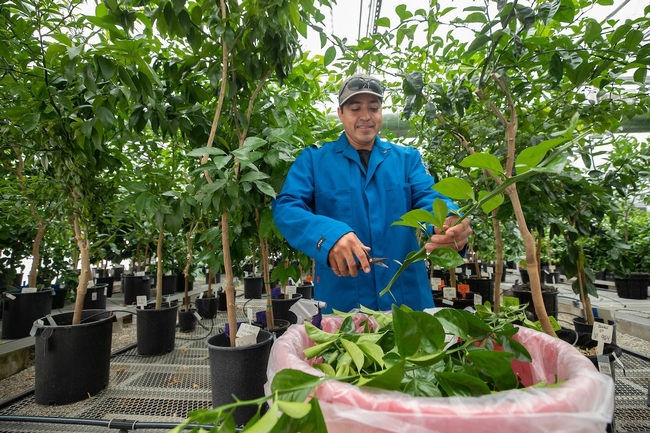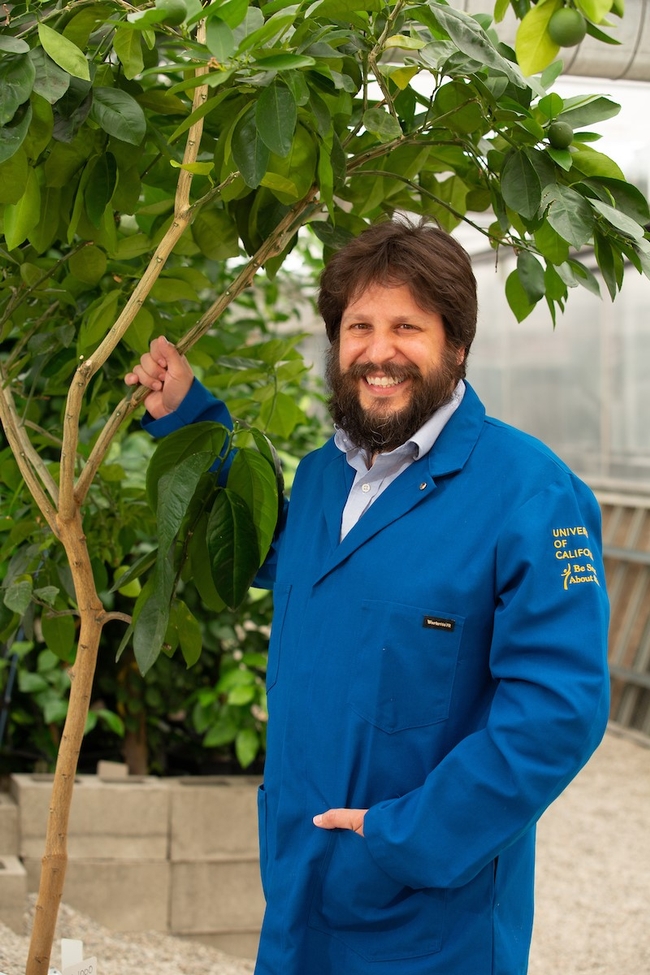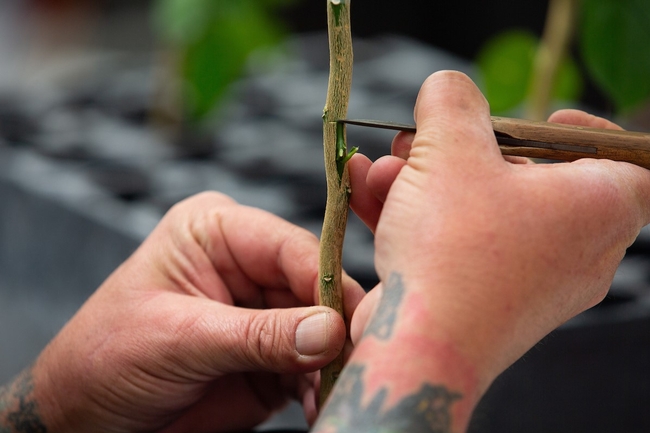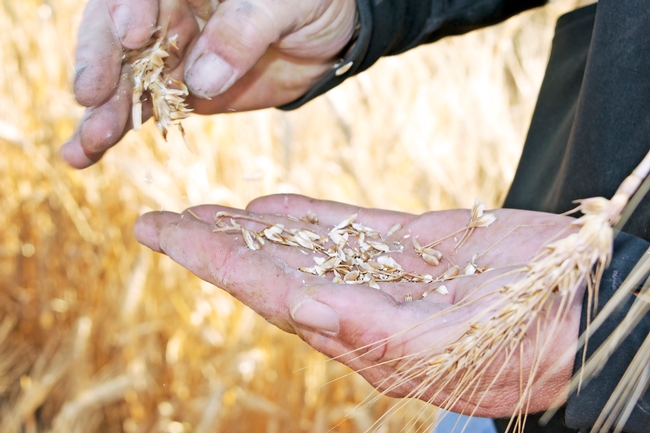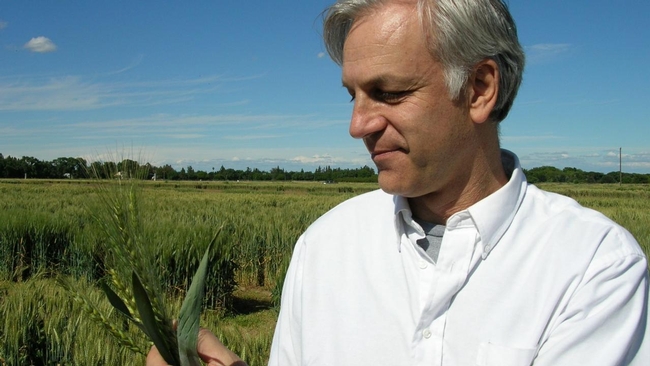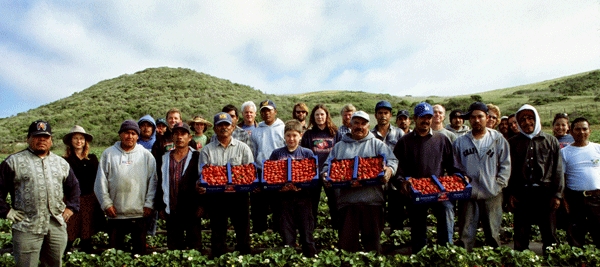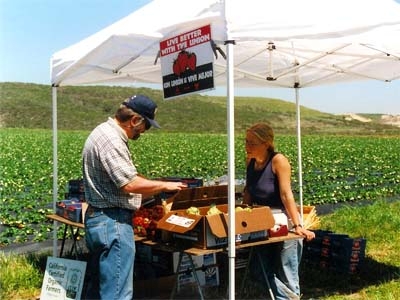Posts Tagged: variety
You, too, can grow California’s oldest living orange variety
Sweet Mother Orange Tree released from quarantine
The 1000th tree okayed for growing by California's Citrus Clonal Protection Program happens to be the oldest living orange variety in the state.
The program, housed at UC Riverside, is the first of its kind in the world. It began in the 1950s, and its scientists spend up to three years testing and clearing citrus trees of disease so they can be released to commercial and private growers.
By law, every citrus tree newly propagated in California can be traced back to one mother tree created at UCR through the protection program. Program Director Georgios Vidalakis and his group begin their process by testing incoming trees for more than 30 citrus diseases, whether the diseases are known to have emerged in the state or not.
The treatment for any disease identified in that first round of testing is to make a new mini tree from a few cells of the original budwood — short, leafless twigs with buds meant for propagation. “We use special plant cells for this process that diseases cannot penetrate,” Vidalakis said.
After the mini tree grows large enough, program scientists go back and do a second round of testing for disease, making sure they picked the right cells for propagation and eliminating any prior trace of illness.
If it passes the arduous second set of tests, the new tree gets a variety index or VI number that accompanies it for the rest of its life, and it is released to the public.
Dubbed the Mother Orange Tree, Bidwell's Bar is a sweet Mediterranean orange brought to California from Mazatlán, Mexico, and planted in 1856. It was first planted near the Bidwell Bar Bridge near Oroville, then dug up and replanted twice.
Its survival skills are some of the reasons Tom Delfino, former California Citrus Nursery Society director, recommended the old orange tree for the protection program.
“Apparently this variety is very rugged,” Delfino said. “Not only has it survived a lot of cold Northern California winters, but the tree has been dug up and replanted twice — once to protect it from impending flood, and again to make way for the Oroville Dam.”
Much of the state's orange industry is based in areas with warm weather. Delfino, who lives in the San Francisco Bay Area, finds citrus an exciting challenge to grow. By suggesting Bidwell's Bar for approval, he was hoping the protection program would clear it so he could buy its budwood.
On the occasions he has visited the original tree, Delfino said the fruit in reaching distance was always gone. “I think it must be tasty because locals grab it for themselves,” he said. “Makes me even more eager to grow and eat my own. I'm extremely pleased the VI testing is completed so I can acquire it.”
Delfino also hopes that this variety will catch on with commercial growers.
“My thought is our citrus industry is concentrated in the southeastern San Joaquin Valley and is subject to a number of pests that like the warm climate there,” Delfino said. “Though this has seeds, which may be a deterrent, it can be grown in colder areas that discourage some of those insects.”
The tree arrived in California nearly two decades before the better-known Washington Navel orange grown by Eliza Tibbets in Riverside. The navel is named for a structure at the bottom end of the fruit, which resembles a belly button. This structure is actually a separate fruit inside the larger fruit. The Washington Navel is also seedless, contributing to its popularity.
“Bidwell's Bar is an example of what was grown in California before the Washington Navel came to dominate, and now that it has a VI number, others can grow it too,” said Tracy Kahn, curator of the Givaudan Citrus Variety Collection at UCR.
Kahn says it's important to preserve the genetic material from a tree with such significance to California. “Some people were worried it was going to die, but now we have an officially cleared source of this historic tree, and it is protected for future generations,” Kahn said.
UC Davis team identifies wheat gene that increases yield
The findings could help growers produce more wheat without expanding operation
A team of scientists from University of California, Davis, have identified a new gene variant in wheat that can increase the amount of the grain produced, new research published in the journal PLOS Genetics finds.
Wheat is a staple of food diets worldwide and the gene discovery could allow farmers to grow more food without increasing land use. Increased yield could also lower consumer prices, making the crop more accessible.
“We have a growing human population that likes to eat every day,” said Jorge Dubcovsky, a plant sciences distinguished professor who led the research. “We need to produce more wheat in the same space so we need plants that are more productive.”
The researchers found a gene – WAPO1 – that controls the maximum number of grains in a wheat spike. Breeding the beneficial gene variant into the plants could delay the formation of the terminal spikelet, providing room for more grains to grow in each spike rather than ending production of grain.
WAPO1 is one of the first genes discovered that can affect wheat yield. “We are trying to make more productive wheat varieties and we are starting to understand how that trait is controlled,” Dubcovsky said.
Pasta wheat lacking the gene
The gene variant for high grain number is found frequently in bread wheats but not in pasta wheats. By breeding the beneficial gene variant into those pasta wheat varieties, growers could increase yield by 4% to 5% in cultivars that have the biomass capacity to fill the extra grains.
“We developed molecular markers to select for the form of that gene to produce increased yield,” Dubcovsky said. “It's a significant step forward.”
Previous research by the team mapped the gene and identified others that could affect yield. This research confirmed those findings for WAPO1.
Discovery on path to future yield increases
The WAPO1 gene is part of a network of genes that work together to control yield, and researchers need to identify the best variant combinations to maximize yield. Solving this puzzle can lead to better production rates.
“We will continue to try to understand the network of genes that control the yield of wheat,” he said.
Saarah Kuzay, Huiqiong Lin, Chengxia Li, Shisheng Chen, Daniel P. Woods and Junli Zhang from UC Davis also contributed to the research, as did scientists from Howard Hughes Medical Institute, Heinrich Heine University and Peking University Institute of Advanced Agricultural Sciences.
Funding was provided by USDAs National Institute of Food and Agriculture's Food Research Initiative, the International Wheat Yield Partnership and Howard Hughes Medical Institute.
U-pick organic strawberry season opens on coast
The U-pick strawberry fields at Swanton Berry Farm near Davenport on the coast are formally opening on May 28, but if you drive out there now, you’ll get a chance to pick without a crowd. Talking to Barrett Boaen, the U-pick manager, I got to the bottom of just why their berries, also sold at local Whole Foods stores, look and taste so good.
Partly it’s the ‘Chandler’ variety, chosen for its old-fashioned sweetness and flavor although it yields only about two-thirds as well as some varieties. It’s also about not pumping up production with too much nitrogen or irrigation (more details here). Mostly, though, it’s about the picking process. A strawberry grower visiting from the East Coast recently bought two flats from the farmstand, saying he couldn’t help himself, he had never laid eyes on such beautiful organic berries, and he knew who to congratulate—the pickers.
You and I are unlikely to come close to picking as well as Swanton’s unionized employees, some of whom have more than 20 years of experience at the farm. They recognize when a strawberry is as ripe as it can be, when it’s red and sweet all the way through (strawberries don’t continue ripening once they are picked). Although a less ripe berry is firmer, with a longer shelf-life and easier to transport, it has less flavor, so the pickers wait a day or two for any berry with a green tip or white shoulders to ripen perfectly. They discard berries that are soft on one side (from raindrops settling on the fruit) or have a cat-face look, which is lygus bug damage.
Moving along the rows, which are banked up to 18 inches high to reduce back strain, they harvest each perfectly ripe berry, with its green calyx attached, in a “twist and flick” motion: “you put tension on the stem above the calyx, and rotate it, so you can see 360 degrees and whether there’s any damage to the berry; then with just the right tension, the berry will pop off naturally,” explains Boaen.
In the U-pick fields, which have ocean views, visitors pick for pleasure, hopping from row to row, enjoying the fresh air, and the fragrance of the berries and the earth. Compared to the serious work in the other 20 acres of strawberries, “the 3 acres of U-pick are a playground,” says Boaen, “We provide people everything they need to be happy.”
“It can be demoralizing,” Boaen admits. “All that energy put into the fruit after the excellent warm January was wrecked.”
Fortunately, the farm has several other crops, and the strawberry fields are filling with new berries. You can pick them this summer for $2.50 per pound (10 percent discount for bicyclists). Bring your own containers if you remember, a windproof jacket and boots in case of fog or mud, and most of all, Boaen recommends allowing plenty of time to enjoy yourself.
By mid-June, Swanton ollalieberries will be ripe, and by mid- or late July, the blackberries will be ready. Farm tours are available by reservation. Organic strawberry and ollalieberry jams, and five other kinds, are available at the farmstand or online.
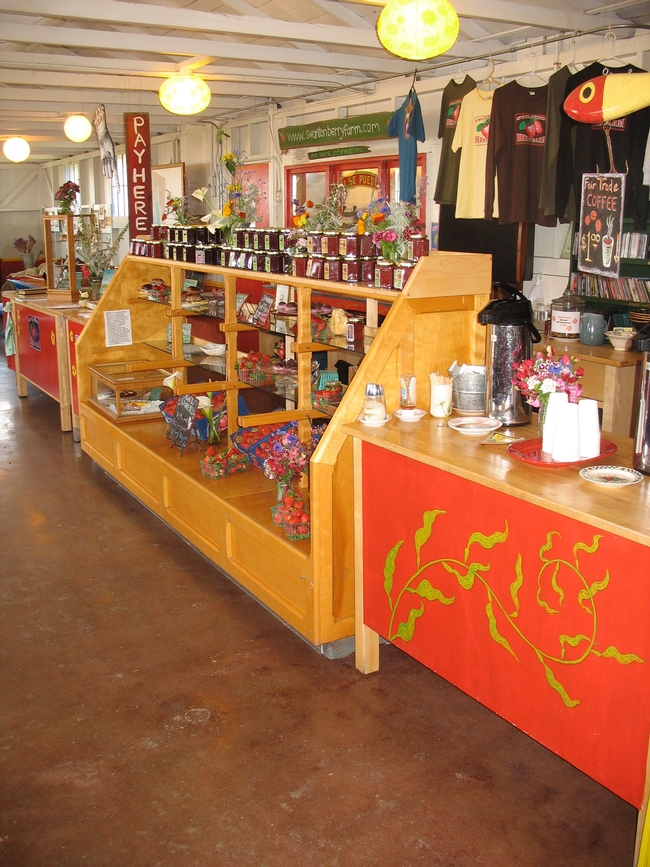
Swanton's farmstand


